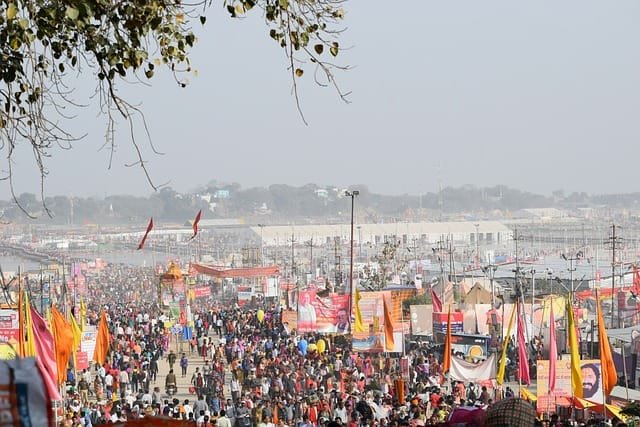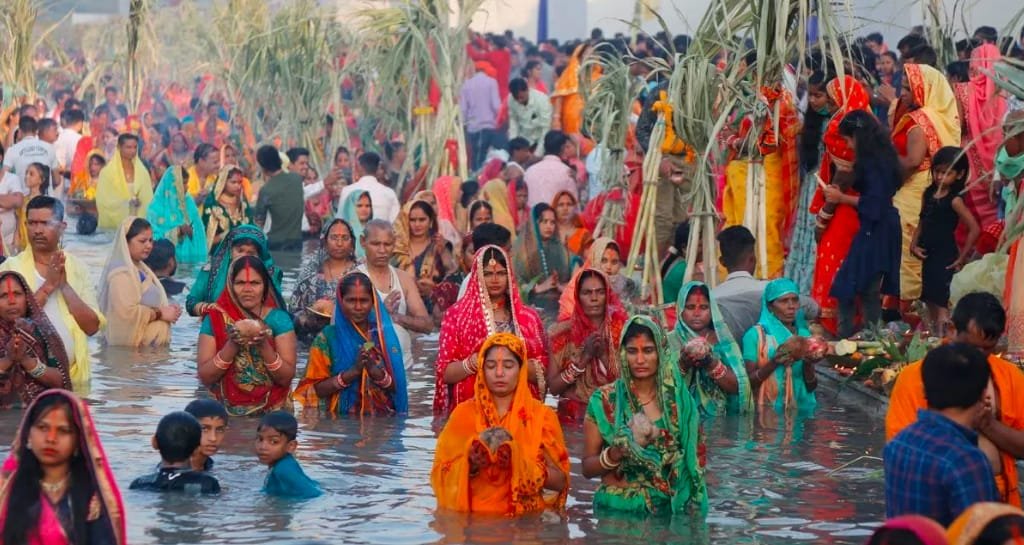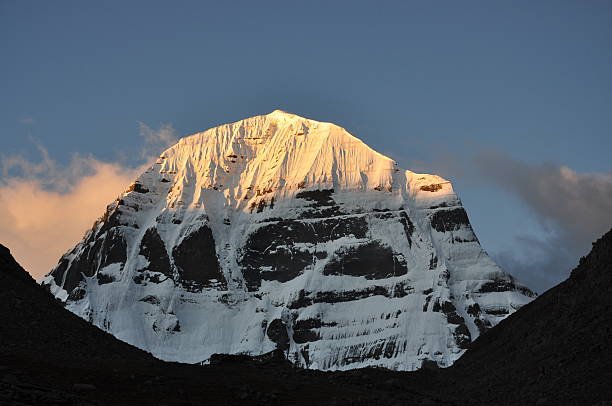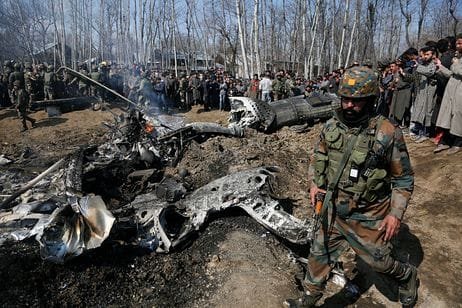Kumbh Mela is organized in Prayagraj from the month of January. Ardh Kumbh is organized after 6 years and Purna Kumbh is organized after 12 years. This fair is the world’s largest religious and cultural symbol. Kumbh Mela lasts for 48 days. Let us know the meaning of Kumbh through this article, why is it celebrated, what is the history behind it, who started the Kumbh Mela, etc.?

If seen, the history of Kumbh Mela is quite old. This fair is very unique in India in which people from all over the world come and take bath in the holy river. It has its own religious significance and is also considered an important symbol of culture. This fair lasts for about 48 days. Mainly devotees like sadhus, saints, ascetics, pilgrims, etc. from all over the world participate in it. But do you know the meaning of Kumbh, why is it celebrated, what is the history behind it, who started the Kumbh Mela etc. Let us study through the article.
According to Hindu mythology, Kumbh Mela is celebrated four times during 12 years. Kumbh Mela is organized in 4 pilgrimage sites. These places are: Haridwar on the Ganga River in Uttarakhand, Ujjain on the Shipra River in Madhya Pradesh, Nashik on the Godavari River in Maharashtra and Prayagraj at the confluence of the three rivers Ganga, Yamuna and Saraswati in Uttar Pradesh. Let us tell you that this year Kumbh Mela has started on January 15, 2019 in Prayagraj, Uttar Pradesh and will continue till March 4, 2019. Earlier in 2003-04, Kumbh Mela was organized in Nashik-Trimbakeshwar.
History of Kumbh Mela
Kumbh Mela is made up of two words Kumbh and Mela. The name Kumbh is derived from the immortal vessel or Kalash of nectar which was kept by the gods and demons as described in the ancient Vedic scriptures called Puranas. Mela, as we are all familiar, is a Sanskrit word meaning ‘gathering’ or ‘meeting’.
There is no authentic information in any scripture about when the Kumbh Mela started in history and who started it, but the oldest description found about it is from the time of Emperor Harshvardhan, which has been done by the famous Chinese pilgrim Hiuen Tsang. According to the Puranas, it is believed that Shankaracharya had started it and according to some stories, Kumbh started with the churning of the ocean. Let us study about this food related to Samudra Manthan.
It is said that when Indra and the gods became weak due to the curse of Maharishi Durvasa, the demon attacked the gods and defeated them. In such a situation, all the gods together went to Lord Vishnu and narrated the entire fast. Then God asked the gods along with the demons to churn the ocean i.e. Kshir Sagar and extract nectar. This milky ocean is located in the celestial region of the universe. At the behest of Lord Vishnu, all the gods made a treaty with the demons and started trying to extract the nectar. As soon as nectar came out from the churning of the ocean, at the behest of the gods, Indra’s son Jayant flew away carrying the nectar pot. On this, at the behest of Guru Shankaracharya, the demons chased Jayant and after a lot of hard work, the demons caught Jayant and for 12 days there was a terrible war between the gods and the demons to gain control over the nectar pot. It is said that during this war, some drops of Amrit Kalash fell at four places on earth. Out of which the first drop fell in Prayag, the second in Haridwar, the third in Ujjain and the fourth in Nashik. That is why Kumbh Mela is organized at these four places. Let us tell you here that 12 days of the gods are equal to 12 years on earth. Therefore Mahakumbh is organized every 12 years.
Now let us know how the date of organizing Kumbh is decided?
The place at which the Kumbh Mela will be organized depends on the zodiac signs. Sun and Jupiter are considered to have special contribution in the Kumbh Mela. Kumbh Mela is celebrated only when Sun and Jupiter move from one zodiac sign to another and the date and place is determined on this basis.
- When Jupiter enters Varshabha zodiac and Sun enters Capricorn then Kumbh Mela is organized in Prayagraj.
- When the Sun enters Aries and Jupiter enters Aquarius, the Kumbh Mela is organized in Haridwar.
- When Sun and Jupiter enter Leo then this Maha Kumbh Mela is celebrated in Nashik.
Kumbh Mela is organized in Ujjain when Jupiter enters Leo and Sun God enters Aries. Let us tell you here that when Sun God enters Leo, that is why the Kumbh celebrated in Ujjain, Madhya Pradesh is called Simhastha Kumbh.
Which planets are considered important in Aquarius?
Among all the nine planets, the role of Sun, Moon, Jupiter and Saturn is considered important in Aquarius. When there was a war going on between the gods and demons over the pot of nectar, the Moon saved the nectar from flowing due to the pull of the pot, the Guru hid the pot, the Sun God saved the pot from bursting and Saturn saved it from the wrath of Indra. Protected. That is why when the combination of these planets occurs in one zodiac sign then Kumbh Mela is organized.
Kumbh is organized every three years. Jupiter stays in one zodiac sign for one year and it takes about 12 years to move to each zodiac sign. That is why Kumbh is organized at the same place every 12 years. Kumbh is held every three years at different places in the four designated places. Prayag has great importance for Kumbh. Mahakumbh is organized here after 144 years.
Types of Kumbh Melas
Mahakumbh Mela: It is organized only in Prayagraj. It comes every 144 years or after 12 complete Kumbh Melas.
Complete Kumbh Mela: It comes every 12 years. Mainly Kumbh Mela is organized in 4 places in India i.e. Prayagraj, Haridwar, Nashik and Ujjain. It comes to these 4 places in rotation every 12 years.
Ardh Kumbh Mela: It means half Kumbh Mela which takes place every 6 years in India only at two places i.e. Haridwar and Prayagraj.
Kumbh Mela: Organized every three years by state governments at four different locations. Lakhs of people participate with spiritual enthusiasm.
Magh Kumbh Mela: It is also known as Mini Kumbh Mela which is organized annually and only in Prayagraj. It is organized in the month of Magha according to the Hindu calendar.
Some interesting facts about Kumbh Mela
- -Kumbh Mela is the world’s largest religious gathering which is also known as “the world’s largest congregation of religious pilgrims”.
- The first written evidence of Kumbh Mela is mentioned in Bhagwat Purana. Another written evidence of the Kumbh Mela is mentioned in the works of the Chinese traveler Hiuen Tsang (or Xuanzang), who visited India in 629–645 AD during the reign of Harshavardhana. Also, Samudra Manthan is also mentioned in Bhagwat Purana, Vishnu Purana, Mahabharata and Ramayana.
- Out of the four cities Prayagraj, Nashik, Haridwar and Ujjain, the Kumbh Mela organized in Prayagraj is the oldest.
- Along with bathing, other activities also take place in Kumbh Mela, sermons, kirtan and Maha Prasad.
- There is no doubt that Kumbh Mela is also a major temporary source of income which provides employment to many people.
- In the Kumbh Mela, the first bath is led by the saints, known as the Shahi Snan of the Kumbh and it starts at 3 am. After the royal bath of the saints, common people are allowed to take bath in the holy river.
- According to Hindu mythology, it is believed that those who take a dip in the waters of these holy rivers become eternally blessed. Not only this, they also become free from sin and it leads them towards the path of salvation.
- Kumbh Mela, the world’s largest gathering, has been included in UNESCO’s representative list of ‘Intangible Cultural Heritage of Humanity’.
- Kumbh Mela is held on those dates when the nectar fell from the sacred pot into these rivers. Every year, the dates are calculated according to the combination of the zodiacal positions of Jupiter, Sun and Moon.
- Kumbh means ‘nectar’ pot. The story of Kumbh Mela dates back to the time when gods resided on earth. They had become weak due to the curse of sage Durvasa and demons were wreaking havoc on the earth.
So now you must have known when, where and how the Kumbh Mela is organised.








